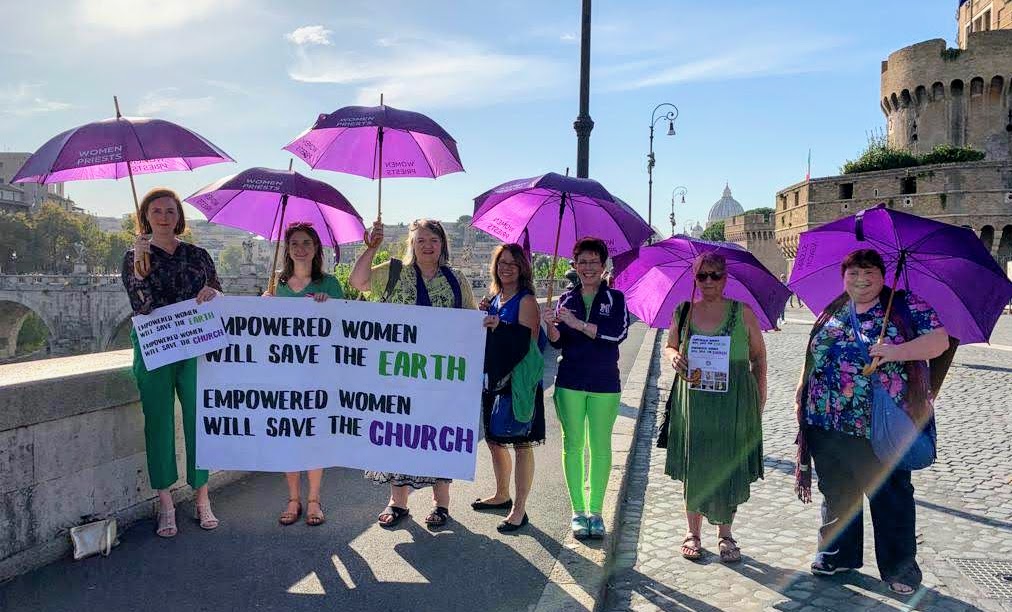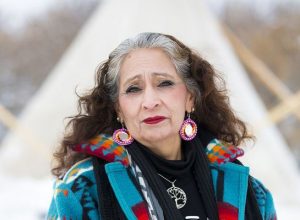“Explosions of Utopian Imagination”
Did you notice the witnesses representing Women’s Ordination Worldwide outside the Amazon Synod last week wore not only purple for gender justice but green for environmental justice? In fact, to emphasize how connected these two issues are, their banners and chants proclaimed: “Empowered Women will Save the Earth. Empowered Women will Save the Church.”

And people noticed…and responded. Such prestigious press services as The Guardian, The New York Times, CRUX, The National Catholic Reporter, Religion News Service, a Korean news outlet, and the Spanish radio covered the witness, and the number of page followers on WOW’s Facebook page went up 98% for the week.
For how long though? Wouldn’t it be amazing and energizing to know the secret of movements that are dynamic enough and last long enough to effect real change?
Renowned author, Naomi Klein, whose books include This Changes Everything: Capitalism vs. the Climate and No Is Not Enough among other international bestsellers, has a theory. She looked at crises in the past that resulted in enormously positive, visionary, and long lasting transformations of individual and collective lives and compared them to the proportionally little progressive change resulting from our response to today’s monumental environmental disasters. She wrote:
Here is one theory. The interplay between lofty dreams and earthly victories has always been at the heart of deep transformation. The breakthroughs won for workers and their families, after the Civil War and during the Great Depression, as well as for civil rights and the environment in the ‘60’s and early ‘70’s were not just responses to crises. They were responses to crises in times when people dared to dream big, out loud, in public – explosions of utopian imagination.
Exactly what, however, does “explosions of utopian imagination” mean? Klein explains: “It means having the courage to point out a different world, one which, even if it exists only in our own minds, can fuel us as we engage in winnable battles…Part of that voyage is not just talking and writing about the future we want – but building it as we go.”
I believe we are envisioning and constructing that future for both the survival and flourishing of the earth and, incidentally and relatedly, for a more inclusive, responsive, just church if only because our church, for good or ill, touches the lives of so many on the earth. And here is further inspiration:
Naomi Klein described her recent time spent at the protest at Standing Rock Reservation against the construction of the Dakota Access Oil Pipeline. She, a woman, stood listening to, and later reflecting on, the wisdom of another woman, Lakota elder LaDonna Brave Bull Allard.
Brave Bull Allard told me she had come to understand that, although stopping the pipeline was crucial, there was something greater at work in this convergence. She said the camps were now a place where indigenous and nonindigenous people alike were learning to live in relationship and community with the land. This moment was also about exposing visitors to the traditions and ceremonies that had been kept alive despite hundreds of years of genocidal attacks on indigenous people and culture. This, she told me, is why the traditions survived the onslaught. ‘We knew this day was coming – the unification of all the tribes….We are here to protect the earth and the water. This is why we are still alive. To do this very thing we are doing. To help humanity answer its most pressing question: How do we live with the earth again and not against it?’”

I liked one line especially, “We are here to protect…,” not to make trouble, not to protest, not to divide people against each other in a cause, but to “protect” the earth by uniting the community in a whirl of challenges and dreams and possibilities.
We want to do the same. And so: We do wear purple. We do wear green. We do champion individual and community responses to the environment and to all peoples. We do have a vision – a “utopian explosion of imagination” if you will. We, of multi-genders and races and ages, by talking, listening, and acting, will protect and reconstruct and renew all of our earthly and spiritual homes.

2 Responses
The patriarchal phase of human history is passing away. Religious patriarchy is becoming obsolete. The apostolic letter “Ordinatio Sacerdotalis” defends the right of church authority to choose whom to ordain (Catechism 1598), but the supporting rationale (Catechism 1577) assumes that a choice made by Jesus during his temporal ministry is normative after the resurrection, and this is not a dogma of the Catholic faith. The church is “one, holy, catholic, and apostolic,” but not necessarily patriarchal. The patriarchal priesthood of the Old Law is no longer normative under the New Law. For the mission of evangelization, for integral human development, and for an integral ecology, the church cannot remain fossilized in the patriarchal culture. It is ludicrous to keep insisting that the great mystery of Christ and the Church is no more than a patriarchal covenant, or that women do not have the same human nature assumed by Christ at the incarnation, or that women are not consubstantial with Christ as to his humanity, or that women are incapable of being sacramentally ordained to act in the person of Christ, or that women cannot be ordained to become successors of the apostles. What goes around comes around, and the male headship syndrome keeps doing harm to the entire body of Christ, and especially to men. In the Catholic Church, we now need celibate women in the priesthood and the episcopate.
Excellent, Ellie, especially on the day the USCCB declines to make the earth the preeminent priority! This gets at why: No majority commitment to that explosion of utopian imagination!